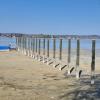Mannenbach’s harbor completely dried – what now?

The world seems to be in order in the tranquil Mannenbach in the Swiss canton of Thurgau, around twelve kilometers west of Constance. The weather is good – walkers, cyclists and restaurant visitors enjoy the warm April sun. But something is different anyway. If you walk along the Bodensee bank, one boat after the other stands there, packed in gray and green foils. Start of the season? Looks different. The boats are literally on the dry. The Mannenbach port is completely dry. Where there were actually clear Lake Constance water on the shore, North Sea feelings come up here. The port looks as if you can walk cotton hiking here instead of driving out to the Lower Sea.
He has never experienced such a low level, says Philemon Diggelmann from the environmental office of the canton of Thurgau. The dry harbor is also a novelty for many of his long -standing employees. « You see that for the first time, you said, » says Diggelmann. After measurements west of Mannenbach, the level was last so low on April 1, 1972 with 394.40 meters above sea level – now it is 394.52 meters.
Missing snow in the catchment area of the Rhine and therefore less meltwater is the reason for the current drought
In the Switzerland If the level, unlike in Germany, is measured based on the sea level, not based on a value above a defined level of the level. In Constance, the level is 2.72 meters and thus around 14 centimeters above the seasonal low. The absolute low value is still 40 centimeters below the current level. Missing snow in the catchment area of the Rhine and thus less meltwater from the Alps Names Diggelmann as the cause. In addition, there is the low rainfall this spring. The weather forecast still looks unfavorable. According to the forecast, rain will be out in the next ten days, and the amount of melting water is not likely to increase.
If you followed reports on the falling Lake Constance level on the Internet these days, you came across such titles at Wetter.de: « Lake Constance has hardly any water left. » That sounds terrifying. And it is also the case that beach sections appear wider or walks on bank sections are possible, where you would otherwise be waded in the water. It is therefore a nice nature experience for everyone who recognizes its leisure value in Lake Constance. But it is also Germany’s largest drinking water memory, and the question arises whether we will be thirsty at some point if the level continues to drop.
Photo: Marina Schölzel
At the Zweckverband Bodensee Water supply (BWV) on the German side in Sipplingen, spokeswoman Teresa Brehme makes it clear: « Fluctuations in the water level are a natural process in Lake Constance and have no effects on drinking water supply. We remove the water at a depth of 70 meters, which is why we are not affected by the fluctuating levels. » And what about climate change? Brehme says: « According to today’s knowledge, we will continue to have enough water in Lake Constance in the future. Climate models predict a temporal shift in the precipitation. » There are then higher rainfall in winter and lower amounts in summer. « The annual amount of the rainfall on the alpine north side and thus in the water catchment area of Lake Constance will remain roughly the same. » The melting or removal of the glaciers has only minor effects on the overall inflow.
Climate change is also unmistakable on Lake Constance
The climate change on Lake Constance is unmistakable. « Exceptional water levels, settlement by plants and animals from distant areas or weaker circulation in winter are some of the evidence, » says Teresa Brehme. « The Lake Constance water supply naturally deals with the possible effects of climate change on Lake Constance and prepares itself. » The provision includes, for example, the expansion of container capacities, replacement current systems and pumps in sufficient numbers.
Photo: Marina Schölzel
Diggelmann runs along the bank in Mannenbach and looks at the dry harbor. The season should actually start on April 13th and the boats that are now on the bottom should be watered. Nothing will become of this – the boat trailers have to be patient, Diggelmann estimates. It could still take a while until the harbor basin is filled again. « This is a very slow process until the water rises again, » says the Swiss. It would take at least one wet spring as in the previous year so that the Mannenbach port quickly fills up again.









